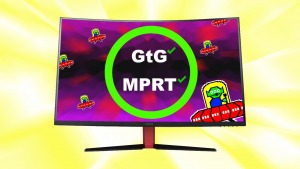Originally Posted MARCH 2013. Updated JUNE 2019
Illustrations of different motion artifacts that affect clarity of moving objects on LCD displays, using the TestUFO Ghosting Test. The UFO objects were moving horizontally at 960 pixels per second on a 60 Hz LCD, and captured using a pursuit camera.
Ghosting
- Ghosting is a trailing motion artifact. It is caused by asymmetric pixel transitions: Transitions from between two colors can be faster in one direction than the other direction. This motion artifact appears only on trailing edges; observe the yellow dome.
Coronas / Inverse Ghosting
- Coronas are trailing artifacts caused by response time acceleration (RTC, overdrive, ASUS Trace-Free, BENQ AMA). Pixels can overshoot their final color value before bouncing back, causing bright inverse ghosting. See LCD Overdrive Artifacts FAQ for more pictures.
Motion Blur
- Motion blur is symmetric for both trailing and leading edges. It is the blurring caused by eye tracking on continuously-displayed refreshes (sample-and-hold). See Pixel Response FAQ: GtG Versus MPRT. Higher refresh rates (120Hz) or flicker (CRT and LightBoost) reduce this type of motion blur.
PWM Artifacts
- PWM artifacts look like repeated images, and can affect motion fludity. PWM represents Pulse-Width Modulation, a technique that many LCD backlights use for dimming screen brightness. Motion artifacts can appear at dim brightness settings. The above photograph was taken during Brightness setting of 0%. See TFTCentral PWM.
How Were These Images Captured?
Stationary Camera: Capture of Pixel Transitions
A stationary camera is good for photographing pixel transitions statically. However, it is not a very accurate representation of perceived display motion blur and motion artifacts:
Example: Stationary camera photo of a moving object on a display.
Pursuit Camera: Accurate Capture of LCD Motion Artifacts
Pursuit camera are used by display manufacturers for testing (e.g. MPRT pursuit cameras). This is simply a camera that follows on-screen motion. These expensive cameras are extremely accurate at measuring motion blur and other artifacts, since they simulate the eye tracking motion of moving eyes.
However, Blur Busters has developed an inexpensive pursuit camera method which operates in conjunction with the Blur Busters UFO Motion Tests. It makes possible accurate photography of motion artifacts. The test at www.testufo.com/ghosting was used to take the pictures on this page. Blur Busters is the world’s first blog to utilize a pursuit camera for accurate capture of motion artifacts, in WYSIWYG format, as seen by the human eye.
Can All LCD Motion Artifacts Be Eliminated?
In some cases, nearly all LCD motion artifacts can be reduced by strobe or eliminated by Motion Blur Reduction settings in new gaming monitors such as ULMB or LightBoost. These are strobe backlight technologies now built into modern gaming monitors that can be turned ON/OFF to enable motion blur reduction. As seen in high-speed video of a strobe backlight in operation, these displays produces CRT motion quality, with all perceptible motion blur completely eliminated.
More Reading About Motion Artifacts & Pixel Response
- See the next article in this series, LCD Motion Artifacts: Overdrive.
- For information about eliminating display motion blur, see Motion Blur Reduction FAQ.
- For more information about pixel response, see GtG versus MPRT: Frequently Asked Questions About Pixel Response.











